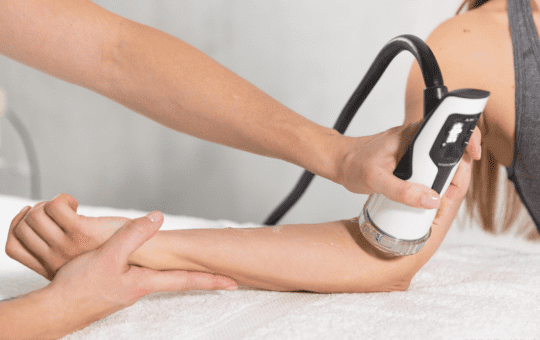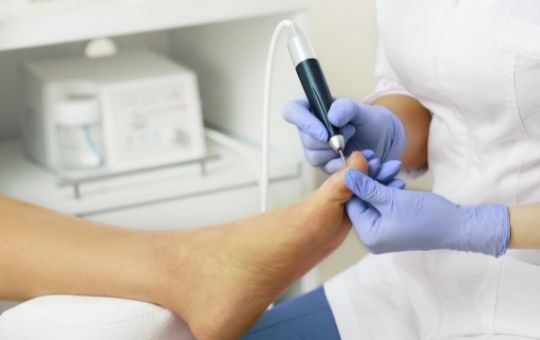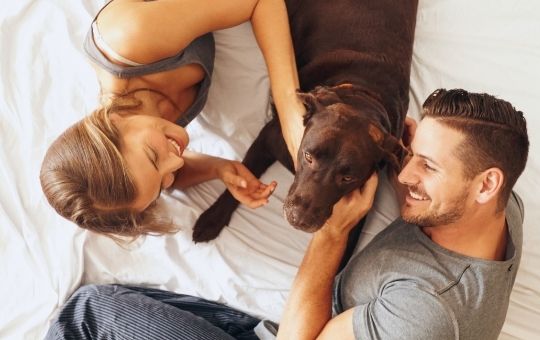Cryotherapy
Cryotherapy is the application of very low temperatures that can be used to treat viral infections of the skin such as verrucae. Verrucae are benign skin growths, usually on the soles of feet, known as plantar warts. They are a non-threatening skin lesion caused by the human papilloma virus (HPV).
Using liquid nitrogen, the affected areas can safely be treated with minimal risk of scarring. This commonly used technique has proven efficacy when treating persistent verrucae, especially when alternative methods have failed.
The advantages of using cryotherapy include high success rates and low complication rates with minimal disruption to your lifestyle. The amount of time taken to freeze the area will vary depending on its size and location with larger lesions requiring more treatments and longer appointments.
Many people find cryotherapy more suitable than alternative methods as it can deliver quicker results and requires less frequent application.
Cryotherapy is not always suitable for everyone. Therefore, our podiatrists will advise if cryotherapy is the most effective course of action within your appointment.
If you are new to the clinic, please book an initial consultation with our podiatrist to discuss your foot ailment. In this appointment you can discuss if cryotherapy is a suitable treatment course.
What does cryotherapy do?
Cryotherapy uses liquid nitrogen, applied directly to an area of skin to freeze and destroy the affected skin cells.
The temperature applied to the skin is around 30 degrees below zero, which causes the skin to blister, and by killing skin cells, the aim is also to kill the virus. Cryotherapy may also stimulate your immune system to fight viral warts.
How effective is cryotherapy at treating verrucae?
Verrucae can be very tricky to treat and get rid of completely.
However, Cryotherapy is recommended for anyone with a verruca as it is a highly effective treatment. The majority of patients treated with cryotherapy will be cured.
How many sessions will I need?
The minimum number of sessions a patient will need is 2.
However, most people will need more sessions, which can be up to 8+, it is completely dependent on each individual’s case and how well the verrucae respond to the treatment. Our podiatrist will assess your foot health and estimate how many sessions you may need. At each follow up assessment appointment, the process will be repeated and a reviewed update on the number of required sessions will be explained as your treatment progresses. After each session, 2 weeks of healing is required before assessment and further treatment can be carried out.
Is it painful?
Cryotherapy can be a little uncomfortable.
Our podiatrist is highly skilled and will handle your feet with the utmost care to keep the discomfort to a minimum. Each patient will have treatment provided based on their comfort levels and individual pain threshold. Some blistering can occur post-treatment which can also cause some discomfort. However, the benefits of treatment outweigh any minor pain it might cause.
What happens to my foot afterwards?
Everyone varies, but usually in the first couple of days it will be fairly normal, other than some possible discomfort.
Then around 3-4 days after treatment, the skin around the treated area will blister, and then around day 5-6-7, the skin will slowly dry out and begin the healing process. This is a fairly standard process, but if you do experience any issues that seem unusual then we always recommend getting back in touch with us to arrange a call with our podiatrist.
What should I avoid after cryotherapy?
After treatment, a dressing will be put on the treated area.
Your podiatrist will advise you on how long you should keep the dressing on but this usually requires you to keep the dressing dry for the first 24-48 hours. You might find that it can be uncomfortable to continue sporting activities, but this doesn’t mean you cannot do it. These types of things can be discussed in your appointment to work out the best treatment and recovery plan for you and your lifestyle.
FAQs
Most times your appointment will be 30 minutes long but can vary depending on each patient. During your appointment the podiatrist will carry out an examination and address any specific concerns you may have, and if appropriate will complete a session of cryotherapy. The actual cryotherapy process consists of freezing in 3 x 20 second bursts of varied intensity with a short break in between each burst.
We usually advise patients to wait a couple of days before they resume physical activity, however, it really is up to the patient based on how their feeling, their individual discomfort levels and how the foot is healing. Again, this can be discussed in further detail during your appointment if you have any specific concerns.
Most warts tend not to ‘fall off’ as many plantar warts, such as verrucae, are actually inverted. In this case, they usually blister and then start the healing process, before another treatment 14 days later, if required.
Yes. You can book an initial appointment (if it is your first appointment) and during that appointment, the podiatrist will carry out an examination and, once you’ve agreed on a treatment plan, can carry out the treatment there and then. However, treatment during an initial appointment, although likely, cannot be guaranteed as the podiatrist may think another course of treatment is more appropriate or possibly even make a referral. Any necessary follow-up appointments will also be discussed.
No, we don’t use any anesthetic because cryotherapy isn’t deemed painful enough to warrant local anaesthetic. In fact, most people would find the anesthetic injection just as uncomfortable as the treatment itself. Some patients have requested it in the past but our podiatrist always explains why we don’t use it and, with his expert touch, none of our patients have felt they needed it after actually having the treatment.
When you remove a verruca or wart, there can be some scarring left behind but this is not normally due to treatment and usually caused by the virus itself. However, almost all scarring is completely unnoticeable and shouldn’t cause any further issues.
Generally speaking, most at home verruca and wart treatment are not very effective and tend not to work successfully. They do not use liquid nitrogen which is what is used during cryotherapy but a weaker gas mixture usually of propane mixed in dimethyl ether. These over the counter home treatments are fine to use if you would prefer but it’s always best to see a podiatrist because what you think is a verruca may sometimes turn out to be something more sinister, such as a skin cancer. Podiatrists can accurately diagnose the issue and recommend treatment options from there.
No. Our podiatrist is highly skilled and knowledgeable and would never administer treatment that could cause frostbite. Treatment is given in 3 x 20 second bursts which is not a prolonged amount of time that could cause frostbite.
It’s far better to tackle a wart as soon as you are aware of it than to leave it to grow bigger, multiply or cause infection in other areas of the same foot or infect both feet. They don’t often clear up on their own, and if on the feet can be painful. If anything unusual appears on your foot, it is always best to see a podiatrist quickly so they can diagnose it for you and recommend appropriate treatment.




